wheel INFINITI QX70 2014 Towing Guide
[x] Cancel search | Manufacturer: INFINITI, Model Year: 2014, Model line: QX70, Model: INFINITI QX70 2014Pages: 25, PDF Size: 0.88 MB
Page 4 of 25
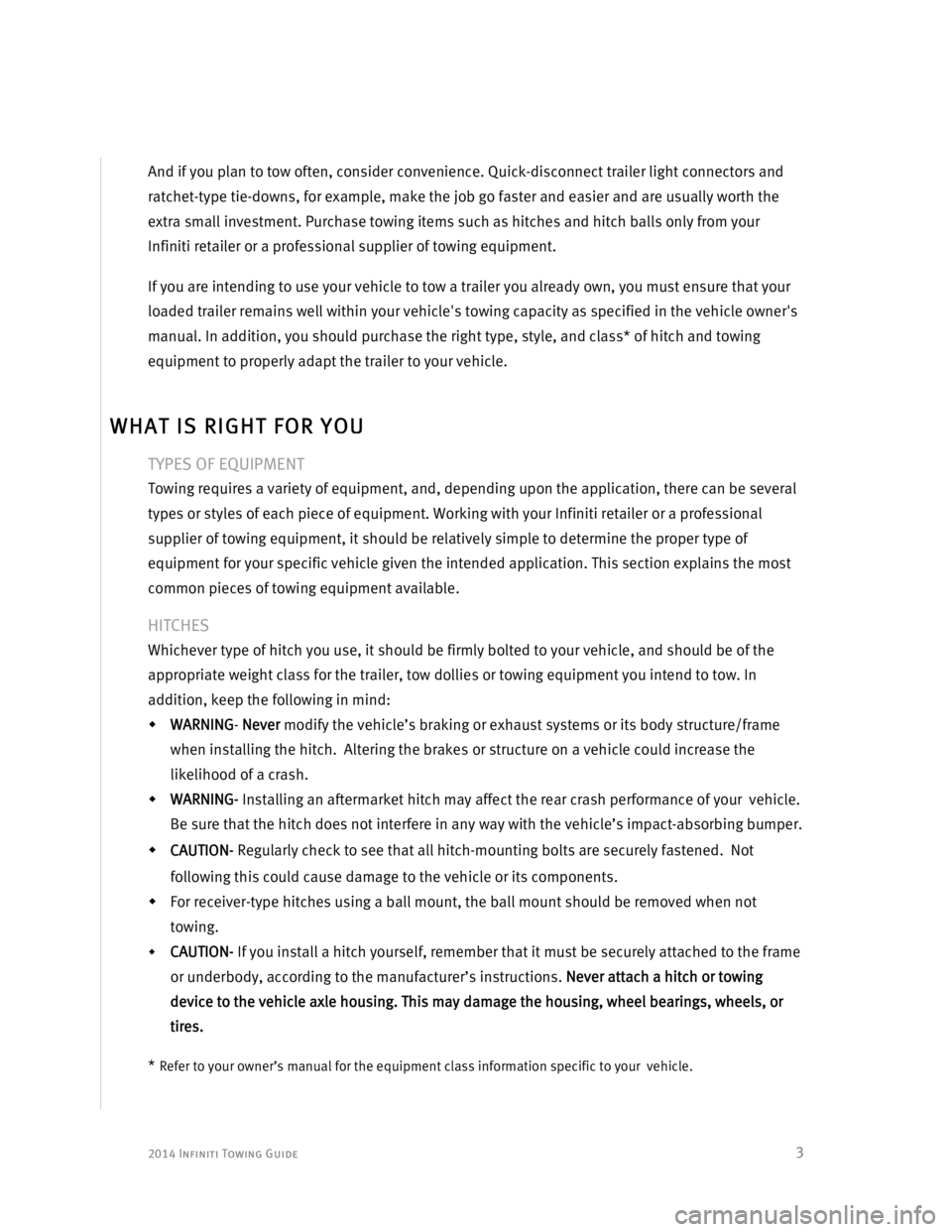
2014 Infiniti Towing Guide
3
And if you plan to tow often, consider convenience. Quick-disconnect trailer light connectors and
ratchet-type tie-downs, for example, make the job go faster and easier and are usually worth the
extra small investment. Purchase towing items such as hitches and hitch balls only from your
Infiniti retailer or a professional supplier of towing equipment.
If you are intending to use your vehicle to tow a trailer you already own, you must ensure that your
loaded trailer remains well within your vehicle's towing capacity as specified in the vehicle owner's
manual. In addition, you should purchase the right type, style, and class* of hitch and towing
equipment to properly adapt the trailer to your vehicle.
TYPES OF EQUIPMENT
Towing requires a variety of equipment, and, depending upon the application, there can be several
types or styles of each piece of equipment. Working with your Infiniti retailer or a professional
supplier of towing equipment, it should be relatively simple to determine the proper type of
equipment for your specific vehicle given the intended application. This section explains the most
common pieces of towing equipment available.
HITCHES
Whichever type of hitch you use, it should be firmly bolted to your vehicle, and should be of the
appropriate weight class for the trailer, tow dollies or towing equipment you intend to tow. In
addition, keep the following in mind:
�Š WARNING- Never modify the vehicle’s braking or exhaust systems or its body structure/frame
when installing the hitch. Altering the brakes or structure on a vehicle could increase the
likelihood of a crash.
�Š WARNING- Installing an aftermarket hitch may affect the rear crash performance of your vehicle.
Be sure that the hitch does not interfere in any way with the vehicle’s impact-absorbing bumper.
�Š CAUTION- Regularly check to see that all hitch-mounting bolts are securely fastened. Not
following this could cause damage to the vehicle or its components.
�Š For receiver-type hitches using a ball mount, the ball mount should be removed when not
towing.
�Š CAUTION- If you install a hitch yourself, remember that it must be securely attached to the frame
or underbody, according to the manufacturer’s instructions. Never attach a hitch or towing
device to the vehicle axle housing. This may damage the housing, wheel bearings, wheels, or
tires.
*
Refer to your owner’s manual for the equipment class information specific to your vehicle.
WHAT IS RIGHT FOR YOU
Page 9 of 25
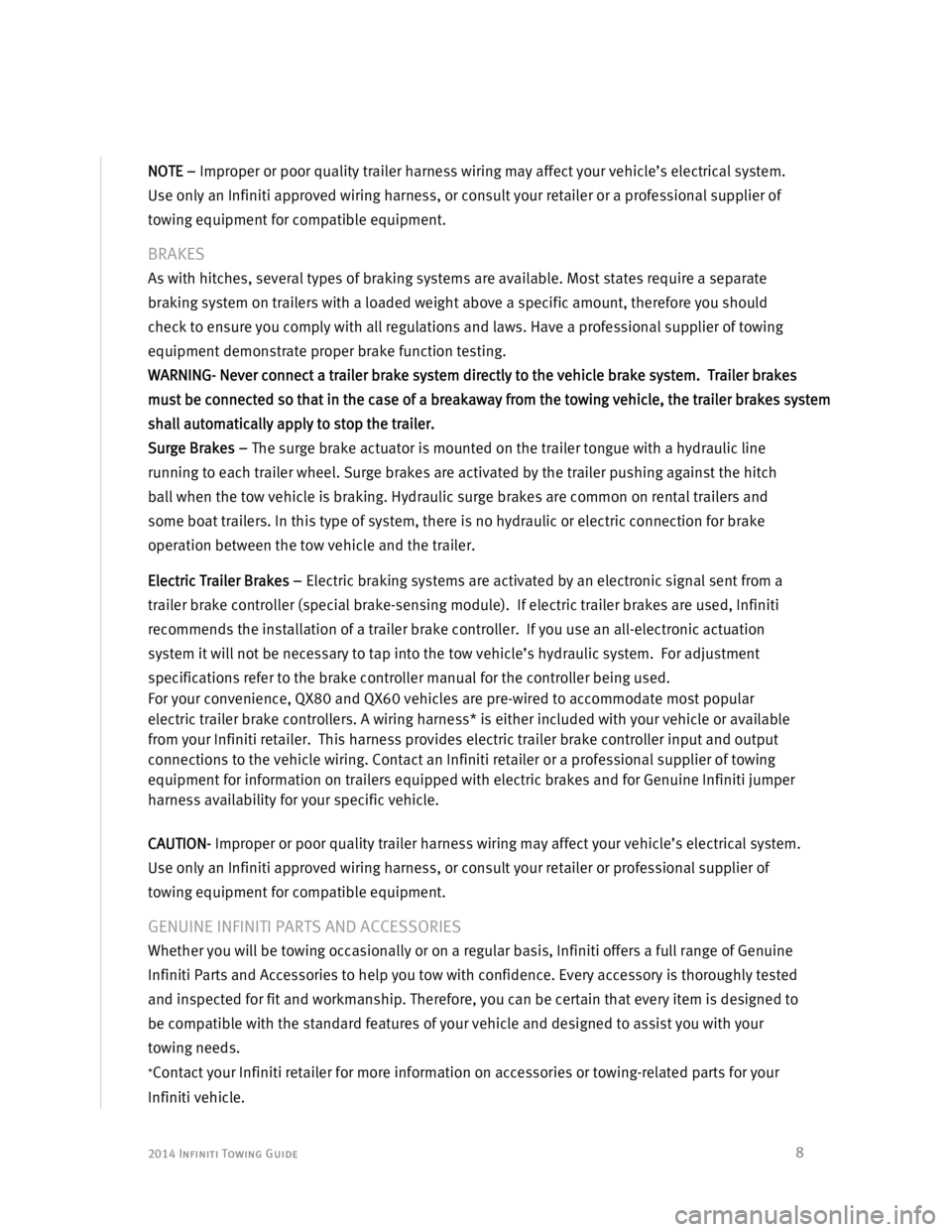
2014 Infiniti Towing Guide
8
NOTE – Improper or poor quality trailer harness wiring may affect your vehicle’s electrical system.
Use only an Infiniti approved wiring harness, or consult your retailer or a professional supplier of
towing equipment for compatible equipment.
BRAKES
As with hitches, several types of braking systems are available. Most states require a separate
braking system on trailers with a loaded weight above a specific amount, therefore you should
check to ensure you comply with all regulations and laws. Have a professional supplier of towing
equipment demonstrate proper brake function testing.
WARNING- Never connect a trailer brake system directly to the vehicle brake system. Trailer brakes
must be connected so that in the case of a breakaway from the towing vehicle, the trailer brakes system
shall automatically apply to stop the trailer.
Surge Brakes – The surge brake actuator is mounted on the trailer tongue with a hydraulic line
running to each trailer wheel. Surge brakes are activated by the trailer pushing against the hitch
ball when the tow vehicle is braking. Hydraulic surge brakes are common on rental trailers and
some boat trailers. In this type of system, there is no hydraulic or electric connection for brake
operation between the tow vehicle and the trailer.
Electric Trailer Brakes – Electric braking systems are activated by an electronic signal sent from a
trailer brake controller (special brake-sensing module). If electric trailer brakes are used, Infiniti
recommends the installation of a trailer brake controller. If you use an all-electronic actuation
system it will not be necessary to tap into the tow vehicle’s hydraulic system. For adjustment
specifications refer to the brake controller manual for the controller being used.
For your convenience, QX80 and QX60 vehicles are pre-wired to accommodate most popular
electric trailer brake controllers. A wiring harness* is either included with your vehicle or available
from your Infiniti retailer. This harness provides electric trailer brake controller input and output
connections to the vehicle wiring. Contact an Infiniti retailer or a professional supplier of towing
equipment for information on trailers equipped with electric brakes and for Genuine Infiniti jumper
harness availability for your specific vehicle.
CAUTION- Improper or poor quality trailer harness wiring may affect your vehicle’s electrical system.
Use only an Infiniti approved wiring harness, or consult your retailer or professional supplier of
towing equipment for compatible equipment.
GENUINE INFINITI PARTS AND ACCESSORIES
Whether you will be towing occasionally or on a regular basis, Infiniti offers a full range of Genuine
Infiniti Parts and Accessories to help you tow with confidence. Every accessory is thoroughly tested
and inspected for fit and workmanship. Therefore, you can be certain that every item is designed to
be compatible with the standard features of your vehicle and designed to assist you with your
towing needs.
*Contact your Infiniti retailer for more information on accessories or towing-related parts for your
Infiniti vehicle.
Page 12 of 25
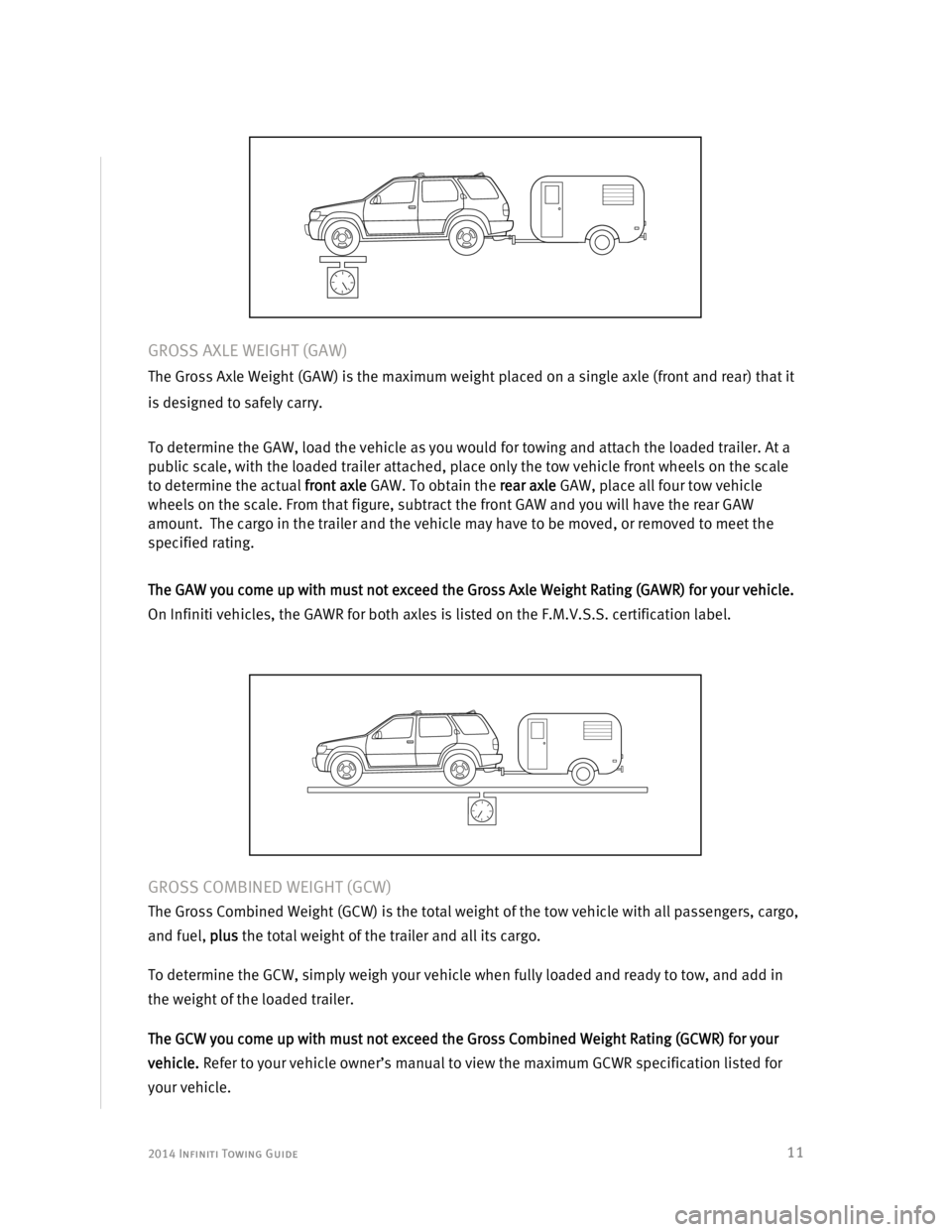
2014 Infiniti Towing Guide
11
GROSS AXLE WEIGHT (GAW)
The Gross Axle Weight (GAW) is the maximum weight placed on a single axle (front and rear) that it
is designed to safely carry.
To determine the GAW, load the vehicle as you would for towing and attach the loaded trailer. At a
public scale, with the loaded trailer attached, place only the tow vehicle front wheels on the scale
to determine the actual front axle GAW. To obtain the rear axle GAW, place all four tow vehicle
wheels on the scale. From that figure, subtract the front GAW and you will have the rear GAW
amount. The cargo in the trailer and the vehicle may have to be moved, or removed to meet the
specified rating.
The GAW you come up with must not exceed the Gross Axle Weight Rating (GAWR) for your vehicle.
On Infiniti vehicles, the GAWR for both axles is listed on the F.M.V.S.S. certification label.
GROSS COMBINED WEIGHT (GCW)
The Gross Combined Weight (GCW) is the total weight of the tow vehicle with all passengers, cargo,
and fuel, plus the total weight of the trailer and all its cargo.
To determine the GCW, simply weigh your vehicle when fully loaded and ready to tow, and add in
the weight of the loaded trailer.
The GCW you come up with must not exceed the Gross Combined Weight Rating (GCWR) for your
vehicle. Refer to your vehicle owner’s manual to view the maximum GCWR specification listed for
your vehicle.
Page 14 of 25
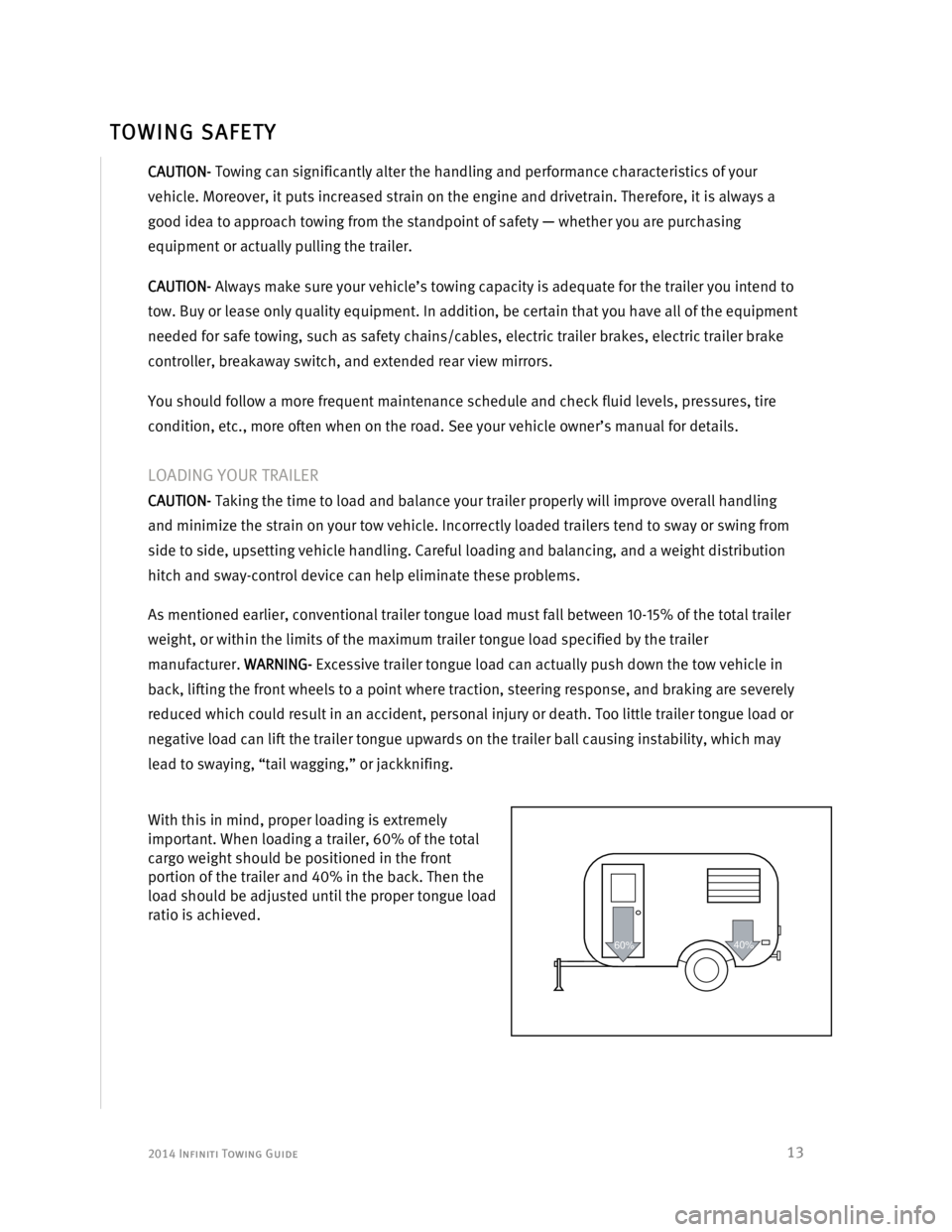
2014 Infiniti Towing Guide
13
CAUTION- Towing can significantly alter the handling and performance characteristics of your
vehicle. Moreover, it puts increased strain on the engine and drivetrain. Therefore, it is always a
good idea to approach towing from the standpoint of safety — whether you are purchasing
equipment or actually pulling the trailer.
CAUTION- Always make sure your vehicle’s towing capacity is adequate for the trailer you intend to
tow. Buy or lease only quality equipment. In addition, be certain that you have all of the equipment
needed for safe towing, such as safety chains/cables, electric trailer brakes, electric trailer brake
controller, breakaway switch, and extended rear view mirrors.
You should follow a more frequent maintenance schedule and check fluid levels, pressures, tire
condition, etc., more often when on the road. See your vehicle owner’s manual for details.
LOADING YOUR TRAILER
CAUTION- Taking the time to load and balance your trailer properly will improve overall handling
and minimize the strain on your tow vehicle. Incorrectly loaded trailers tend to sway or swing from
side to side, upsetting vehicle handling. Careful loading and balancing, and a weight distribution
hitch and sway-control device can help eliminate these problems.
As mentioned earlier, conventional trailer tongue load must fall between 10-15% of the total trailer
weight, or within the limits of the maximum trailer tongue load specified by the trailer
manufacturer. WARNING- Excessive trailer tongue load can actually push down the tow vehicle in
back, lifting the front wheels to a point where traction, steering response, and braking are severely
reduced which could result in an accident, personal injury or death. Too little trailer tongue load or
negative load can lift the trailer tongue upwards on the trailer ball causing instability, which may
lead to swaying, “tail wagging,” or jackknifing.
With this in mind, proper loading is extremely
important. When loading a trailer, 60% of the total
cargo weight should be positioned in the front
portion of the trailer and 40% in the back. Then the
load should be adjusted until the proper tongue load
ratio is achieved.
60%40%
TOWING SAFETY
Page 15 of 25
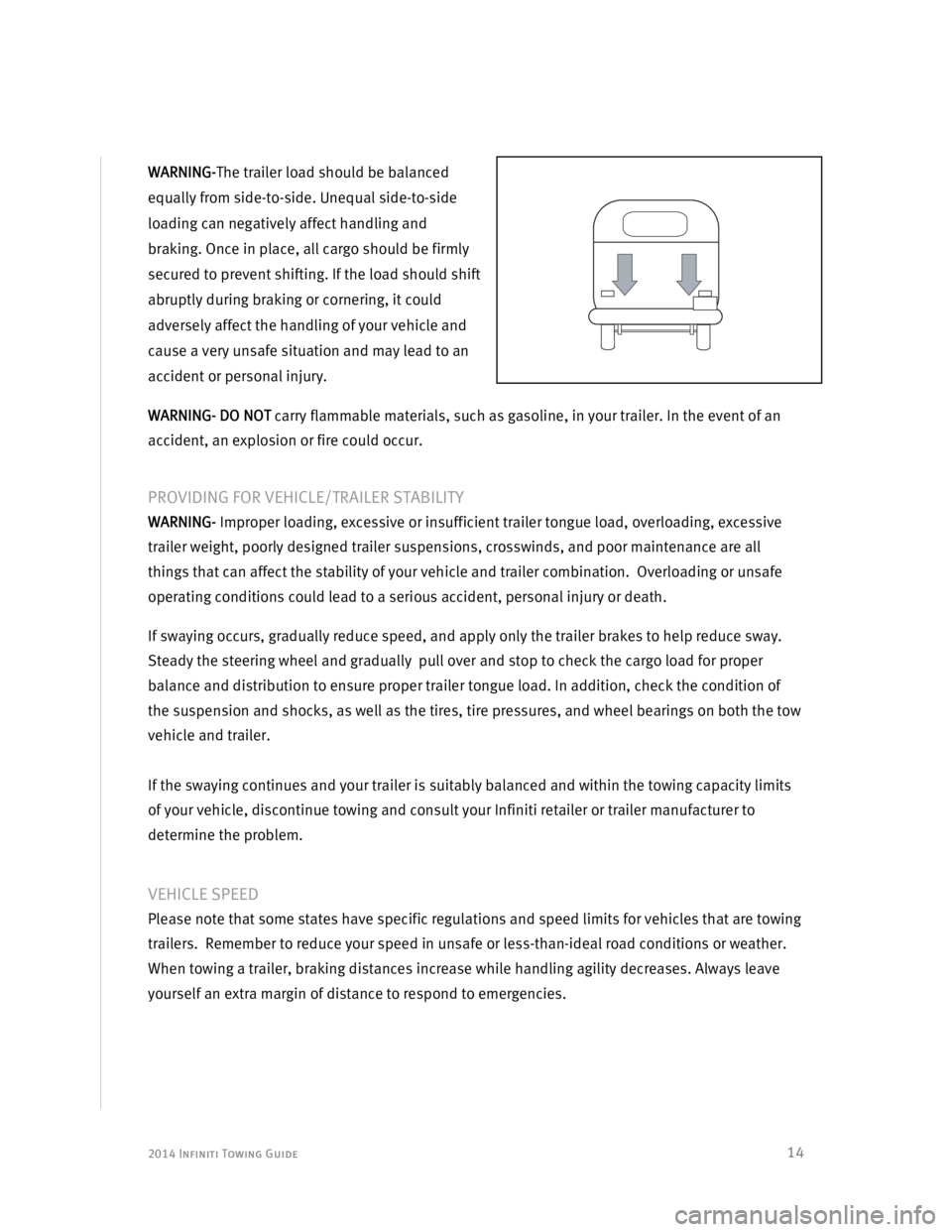
2014 Infiniti Towing Guide
14
WARNING-The trailer load should be balanced
equally from side-to-side. Unequal side-to-side
loading can negatively affect handling and
braking. Once in place, all cargo should be firmly
secured to prevent shifting. If the load should shift
abruptly during braking or cornering, it could
adversely affect the handling of your vehicle and
cause a very unsafe situation and may lead to an
accident or personal injury.
WARNING- DO NOT carry flammable materials, such as gasoline, in your trailer. In the event of an
accident, an explosion or fire could occur.
PROVIDING FOR VEHICLE/TRAILER STABILITY
WARNING- Improper loading, excessive or insufficient trailer tongue load, overloading, excessive
trailer weight, poorly designed trailer suspensions, crosswinds, and poor maintenance are all
things that can affect the stability of your vehicle and trailer combination. Overloading or unsafe
operating conditions could lead to a serious accident, personal injury or death.
If swaying occurs, gradually reduce speed, and apply only the trailer brakes to help reduce sway.
Steady the steering wheel and gradually pull over and stop to check the cargo load for proper
balance and distribution to ensure proper trailer tongue load. In addition, check the condition of
the suspension and shocks, as well as the tires, tire pressures, and wheel bearings on both the tow
vehicle and trailer.
If the swaying continues and your trailer is suitably balanced and within the towing capacity limits
of your vehicle, discontinue towing and consult your Infiniti retailer or trailer manufacturer to
determine the problem.
VEHICLE SPEED
Please note that some states have specific regulations and speed limits for vehicles that are towing
trailers. Remember to reduce your speed in unsafe or less-than-ideal road conditions or weather.
When towing a trailer, braking distances increase while handling agility decreases. Always leave
yourself an extra margin of distance to respond to emergencies.
Page 17 of 25
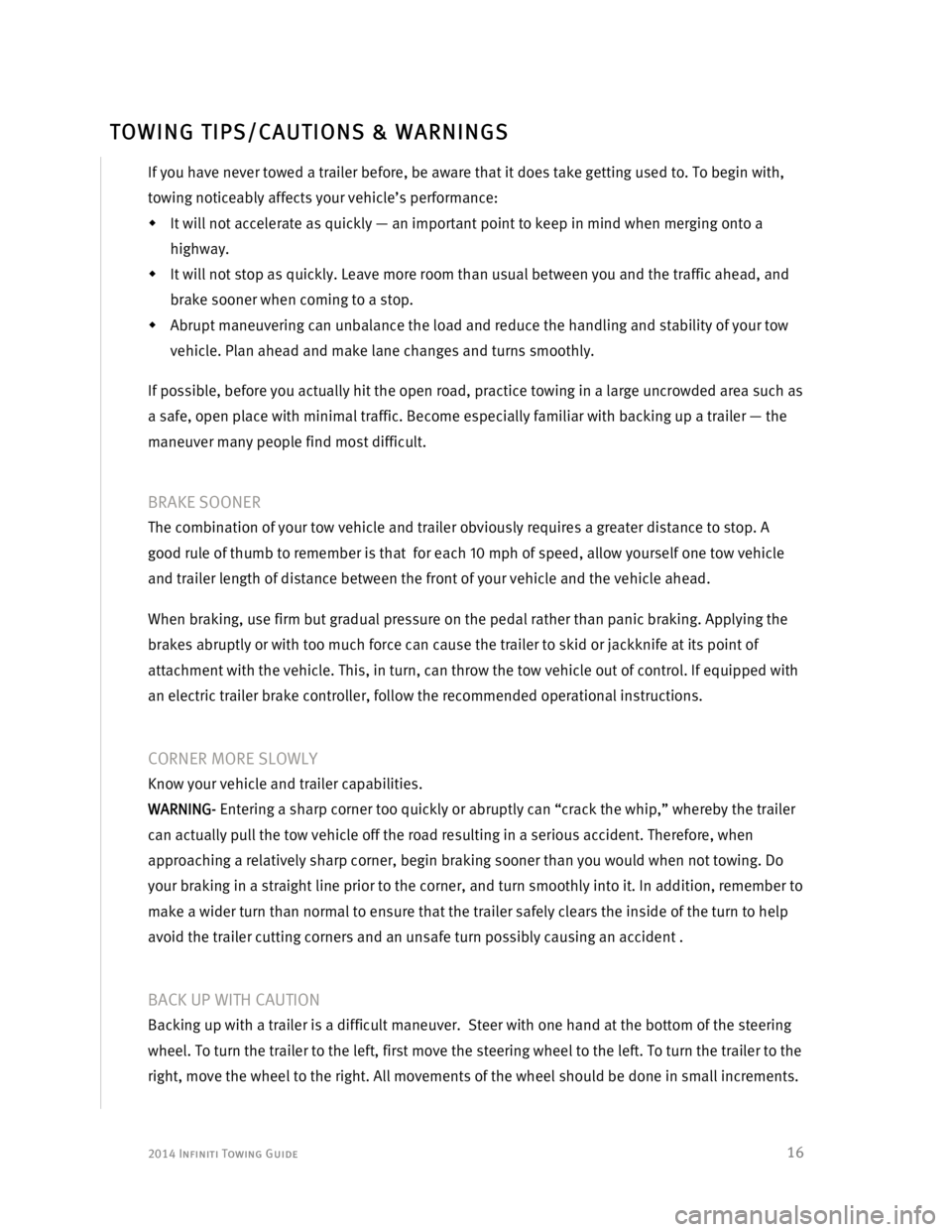
2014 Infiniti Towing Guide
16
If you have never towed a trailer before, be aware that it does take getting used to. To begin with,
towing noticeably affects your vehicle’s performance:
�Š It will not accelerate as quickly — an important point to keep in mind when merging onto a
highway.
�Š It will not stop as quickly. Leave more room than usual between you and the traffic ahead, and
brake sooner when coming to a stop.
�Š Abrupt maneuvering can unbalance the load and reduce the handling and stability of your tow
vehicle. Plan ahead and make lane changes and turns smoothly.
If possible, before you actually hit the open road, practice towing in a large uncrowded area such as
a safe, open place with minimal traffic. Become especially familiar with backing up a trailer — the
maneuver many people find most difficult.
BRAKE SOONER
The combination of your tow vehicle and trailer obviously requires a greater distance to stop. A
good rule of thumb to remember is that for each 10 mph of speed, allow yourself one tow vehicle
and trailer length of distance between the front of your vehicle and the vehicle ahead.
When braking, use firm but gradual pressure on the pedal rather than panic braking. Applying the
brakes abruptly or with too much force can cause the trailer to skid or jackknife at its point of
attachment with the vehicle. This, in turn, can throw the tow vehicle out of control. If equipped with
an electric trailer brake controller, follow the recommended operational instructions.
CORNER MORE SLOWLY
Know your vehicle and trailer capabilities.
WARNING- Entering a sharp corner too quickly or abruptly can “crack the whip,” whereby the trailer
can actually pull the tow vehicle off the road resulting in a serious accident. Therefore, when
approaching a relatively sharp corner, begin braking sooner than you would when not towing. Do
your braking in a straight line prior to the corner, and turn smoothly into it. In addition, remember to
make a wider turn than normal to ensure that the trailer safely clears the inside of the turn to help
avoid the trailer cutting corners and an unsafe turn possibly causing an accident .
BACK UP WITH CAUTION
Backing up with a trailer is a difficult maneuver. Steer with one hand at the bottom of the steering
wheel. To turn the trailer to the left, first move the steering wheel to the left. To turn the trailer to the
right, move the wheel to the right. All movements of the wheel should be done in small increments.
TOWING TIPS/CAUTIONS & WARNINGS
Page 18 of 25
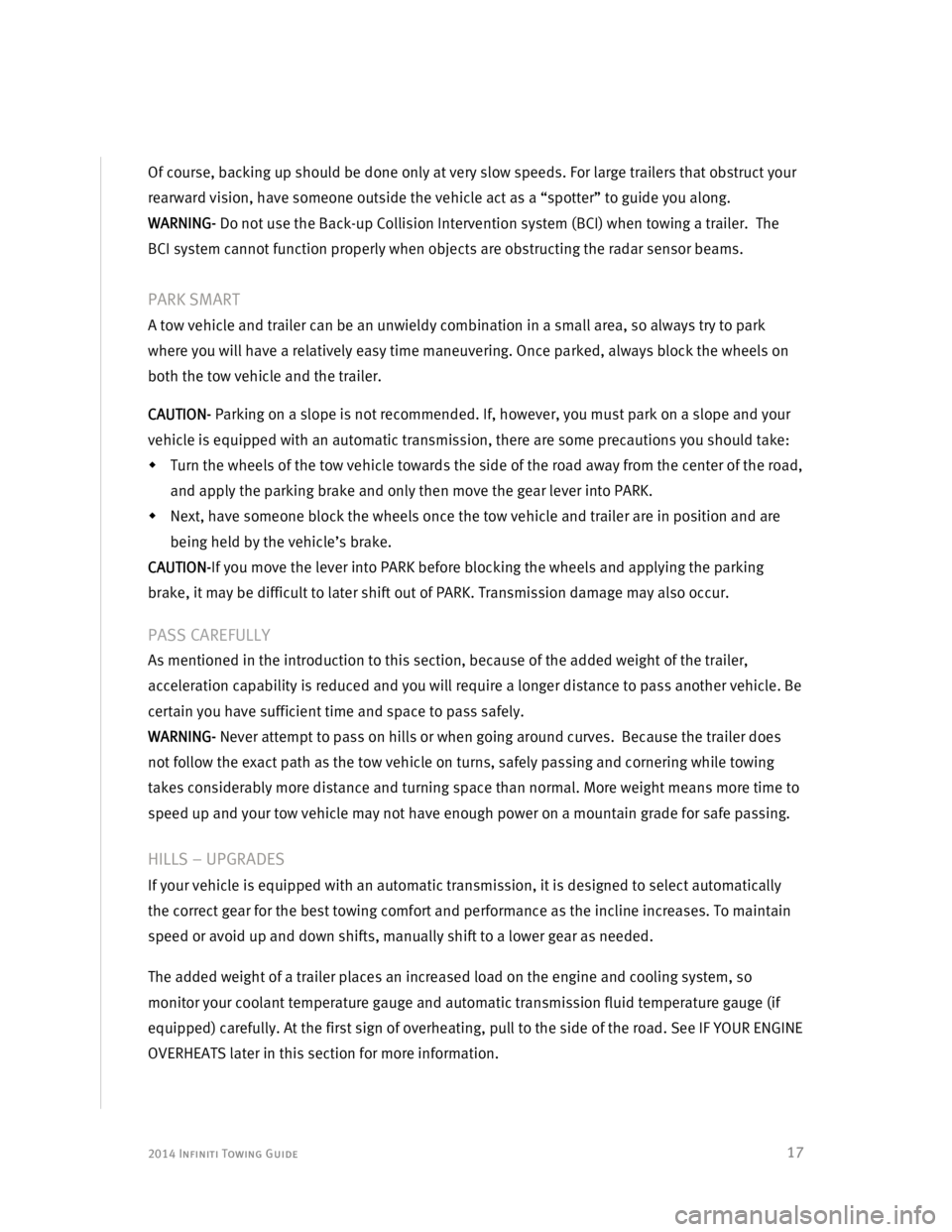
2014 Infiniti Towing Guide
17
Of course, backing up should be done only at very slow speeds. For large trailers that obstruct your
rearward vision, have someone outside the vehicle act as a “spotter” to guide you along.
WARNING- Do not use the Back-up Collision Intervention system (BCI) when towing a trailer. The
BCI system cannot function properly when objects are obstructing the radar sensor beams.
PARK SMART
A tow vehicle and trailer can be an unwieldy combination in a small area, so always try to park
where you will have a relatively easy time maneuvering. Once parked, always block the wheels on
both the tow vehicle and the trailer.
CAUTION- Parking on a slope is not recommended. If, however, you must park on a slope and your
vehicle is equipped with an automatic transmission, there are some precautions you should take:
�Š Turn the wheels of the tow vehicle towards the side of the road away from the center of the road,
and apply the parking brake and only then move the gear lever into PARK.
�Š Next, have someone block the wheels once the tow vehicle and trailer are in position and are
being held by the vehicle’s brake.
CAUTION-If you move the lever into PARK before blocking the wheels and applying the parking
brake, it may be difficult to later shift out of PARK. Transmission damage may also occur.
PASS CAREFULLY
As mentioned in the introduction to this section, because of the added weight of the trailer,
acceleration capability is reduced and you will require a longer distance to pass another vehicle. Be
certain you have sufficient time and space to pass safely.
WARNING- Never attempt to pass on hills or when going around curves. Because the trailer does
not follow the exact path as the tow vehicle on turns, safely passing and cornering while towing
takes considerably more distance and turning space than normal. More weight means more time to
speed up and your tow vehicle may not have enough power on a mountain grade for safe passing.
HILLS – UPGRADES
If your vehicle is equipped with an automatic transmission, it is designed to select automatically
the correct gear for the best towing comfort and performance as the incline increases. To maintain
speed or avoid up and down shifts, manually shift to a lower gear as needed.
The added weight of a trailer places an increased load on the engine and cooling system, so
monitor your coolant temperature gauge and automatic transmission fluid temperature gauge (if
equipped) carefully. At the first sign of overheating, pull to the side of the road. See IF YOUR ENGINE
OVERHEATS later in this section for more information.